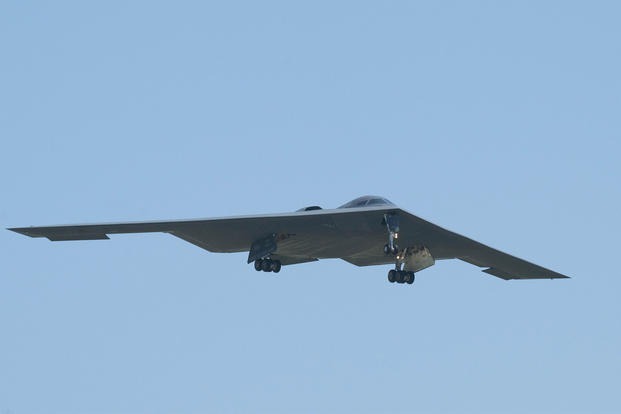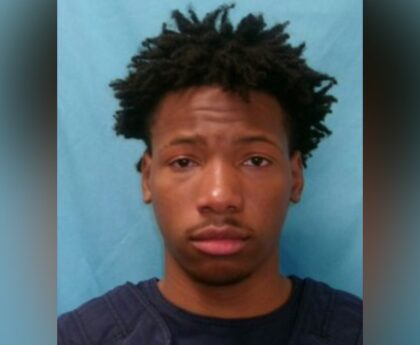
Operation Midnight Hammer, the name of the U.S. military’s coordinated strikes against three of Iran’s nuclear facilities last weekend, marked the longest B-2 Spirit stealth bomber mission since 2001 and the inaugural use of the 30,000-pound Massive Ordnance Penetrator bomb in combat.
Defense Secretary Pete Hegseth praised the work of “our boys in those bombers” during a press conference at the Pentagon on Sunday.
But female troops also played key roles in the Iran strikes. “Women were incorporated in all aspects of the mission,” a U.S. official told Military.com on Monday on condition of anonymity to discuss details of the operation.
Read Next: Iran Still Threat to US Forces in Middle East Despite Strikes, Admiral Says
At least one woman served as a B-2 bomber pilot during the mission, that official said. Another official confirmed women were on a guided missile submarine crew that launched more than two dozen cruise missiles at the Iranian nuclear sites.
It’s a historic achievement because the B-2s and submarines at the tip of the U.S. military spear have, historically, not been manned by women.
Some retired female pilots brushed off the secretary’s choice of words, but those who spoke with Military.com said it seemed to track with his other recent comments, as well as Hegseth’s past public opposition to female service members taking on combat roles.
Retired Lt. Col. Jessica Ruttenber, an Air Force pilot who flew numerous planes including the KC-135 Stratotanker — a refueling aircraft — told Military.com in an interview Monday that she could understand if he was speaking generally when referring to “our boys” but said his views and rhetoric in the past call for more scrutiny.
“When you say ‘boys,’ given his history, his track record, you would think he’d be more conscious of the language he’s using, especially with high visibility,” Ruttenber said. “It matters.”
Prior to his confirmation as defense secretary, Hegseth spoke out about women in combat roles during media interviews.
“I’m straight up just saying we should not have women in combat roles. It hasn’t made us more effective. Hasn’t made us more lethal. Has made fighting more complicated,” Hegseth said in November on a podcast hosted by Shawn Ryan, a former Navy SEAL.
He later softened those comments during his confirmation hearing in January, stating he wanted to make physical standards between men and women the same.
Just this past month, when questioned during a House Armed Services Committee hearing by Rep. Chrissy Houlahan, D-Pa., Hegseth wouldn’t answer yes or no when asked “whether women should be in all roles in the military,” responding only that “it’s all about standards.”
After several news outlets reported that there was at least one female pilot among the B-2 pilots — contradicting Hegseth’s remarks at the press conference — the Pentagon’s Rapid Response account repeated the phrase in a post to social media on Sunday evening.
“Welcome home boys!” the account proclaimed over footage of the bombers landing in Missouri.
The B-2 pilot community is small. As of 2022, Air Force Global Strike Command said there had been just over 500 B-2 pilots assigned a “spirit number”– a tradition in which those who fly in the aircraft, including passengers, are tracked.
A Whiteman Air Force Base news release announcing the 2019 graduation of a female B-2 pilot stated there had been only 10 women to fly the stealth bomber at that time.
Retired Air Force Brig. Gen. Kristin Goodwin is among those pilots.
In addition to flying the B-2 and other aircraft, Goodwin previously served as the vice commander of the 509th Bomb Wing at Whiteman and later as the commander of the 2nd Bomb Wing at Barksdale Air Force Base, among numerous other positions at the Pentagon, according to her service biography.
She told Military.com in an interview Monday that she’s faced harsh comments as a female pilot in a largely male-dominated community but that never stopped her from focusing on the mission.
“I’ve heard that women should be in the kitchen, women shouldn’t be in combat, women can’t fly. I’ve heard all the things that we can’t do,” Goodwin said. “To me, what’s really important, personally, is that I know that I know how to do my job, that I show up every day ready to execute, to do the mission that I was called to do.”
Goodwin said the Iran operation was a testament to the B-2 pilot community as well as the refuelers, maintainers and other support roles. It’s also a mission she was personally familiar with.
“This mission is not something that they scrambled to put together,” she said. “It was a mission that I knew when I was in. I knew the targets and the training.”
Just like the Air Force B-2 pilots, the women involved with the submarine strikes for Operation Midnight Hammer are also a small community.
As a result of its history and structure, the Navy’s submarine service — which is all-volunteer and was all male up to 2010 — was, until recently, seen as something akin to a combat role.
When the service began undertaking integration efforts, there was a spate of scandals that plagued early female submariners. One case involved nearly a dozen sailors secretly recording their female shipmates while they showered. Then, in 2019, sailors aboard the USS Florida were investigated and punished over allegations of a “rape list” of female sailors stationed aboard the submarine.
However, since then, women have slowly made progress in the community and, now, an official told Military.com on Monday, there are more than 800 female officers and enlisted sailors serving on submarines.
There is also a growing cadre of female sailors who have begun to take leadership roles in the community. Two years ago, the Navy announced that a female sailor, one of the first to serve on submarines, was named as the USS Louisiana’s top enlisted official. The same year, the Navy also tapped a female officer to serve as the first executive officer of a submarine.
The women involved in Operation Midnight Hammer have not been publicly named by the Pentagon or services and, given the small number of female aviators in the stealth bomber and submarine community, for example, it is likely seen as an operational security concern.
“I don’t know her name, I don’t know the guys’ names,” Goodwin told Military.com, speaking of the B-2 pilots. “She was put on there because she was qualified and she was ready to execute that mission, just like the guys were. No other reason.”
Related: Thousands of Women Serve in Combat Roles. Pentagon Nominee Hegseth Says They Shouldn’t.




